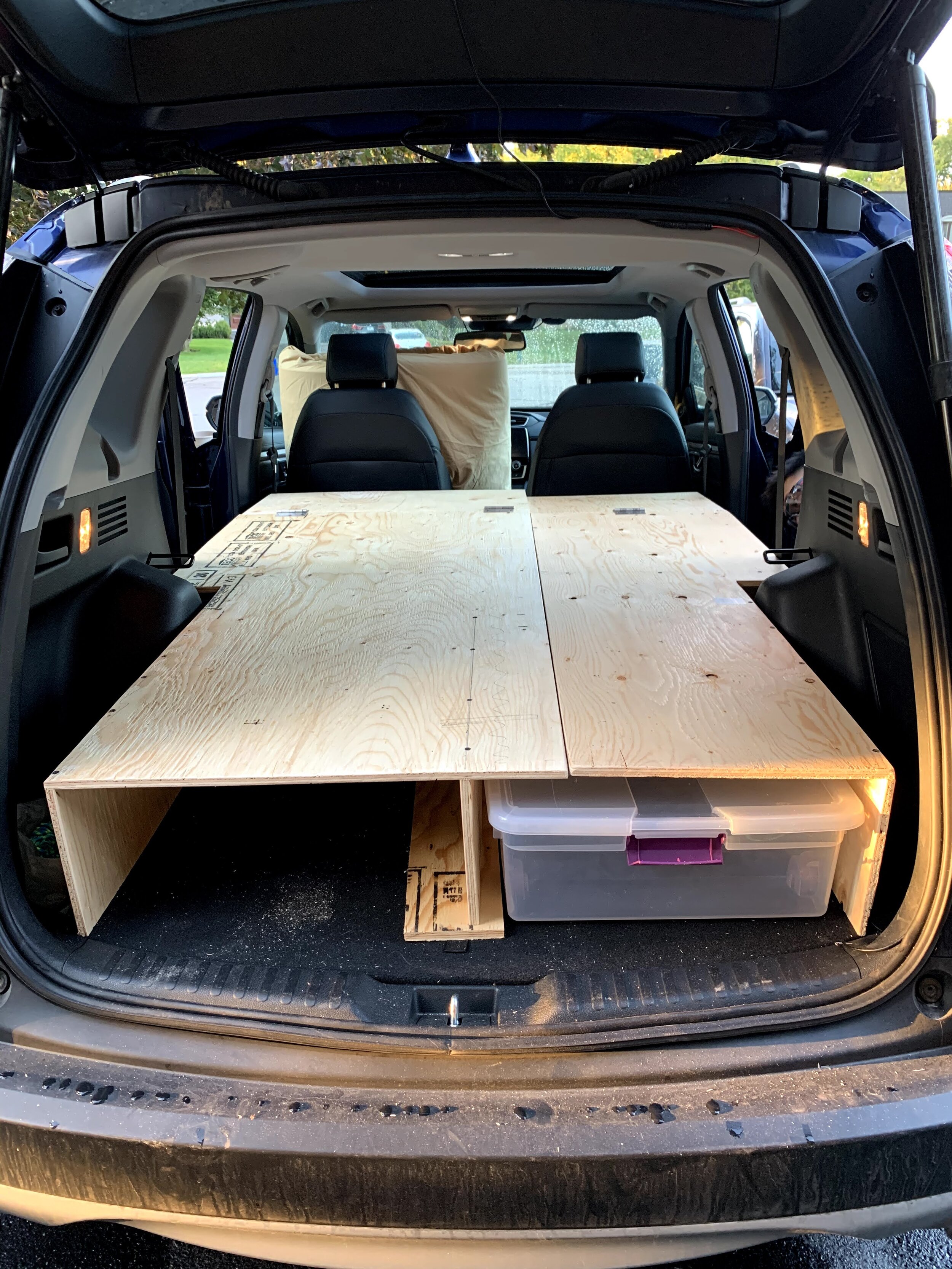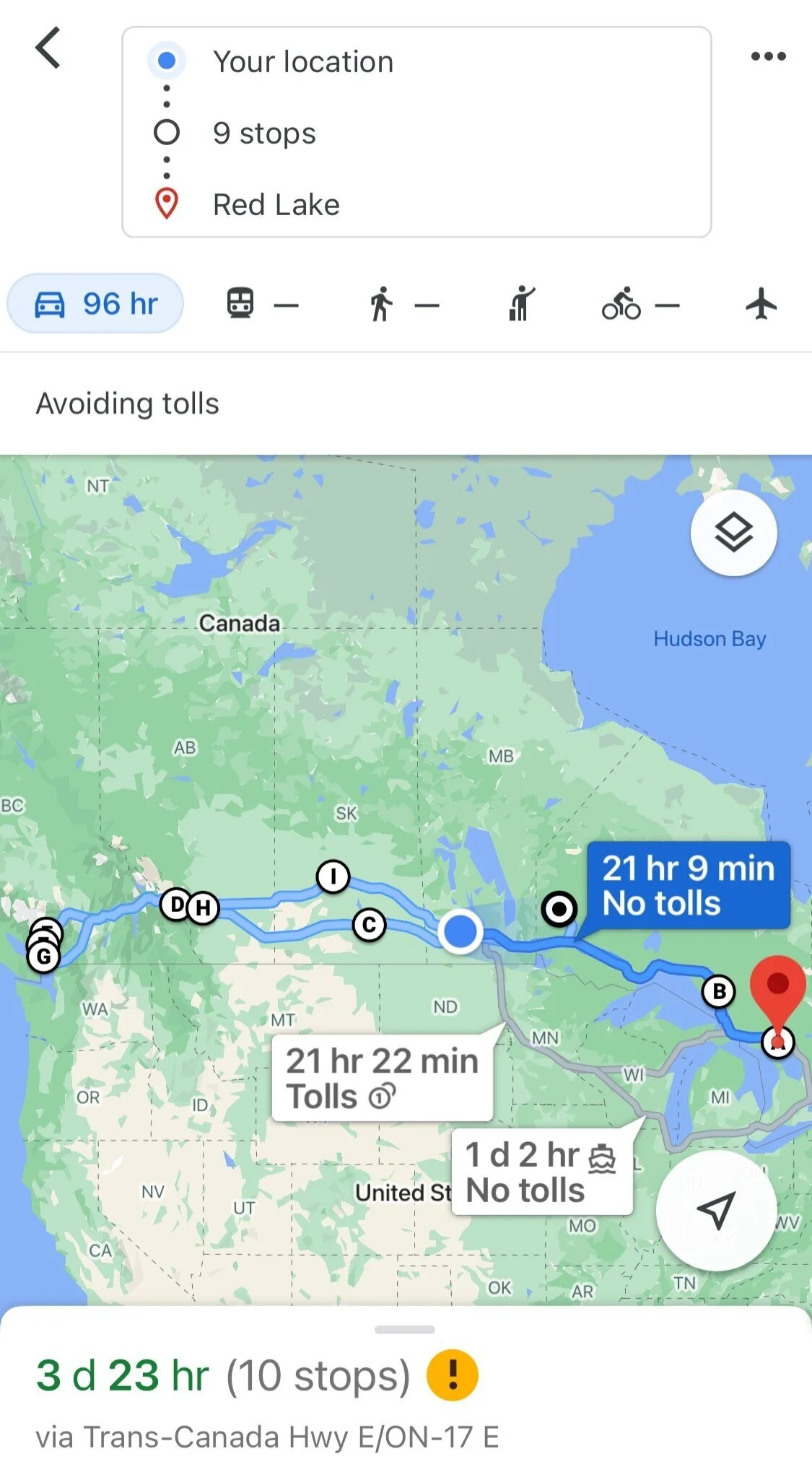Car Camping in a Honda CR-V
Living during a global pandemic, nowhere to travel and an abundance of PTO was the trifecta that led us to embark on a car camping adventure. Not everyone can live the #VanLife but anyone can sleep in a car! Let this blog post be the catalyst for your car-camping road trip 🚙
The platform
Going into the build, I had the following principles in mind:
Since we were going in winter (#SnowsuitSeason) I wanted to maximize storage while ensuring we had enough headroom when on top of the platform.
I did not want to remove the seats or make any permanent changes to the SUV
Easy access to the footwells would be necessary in order to store and use the Yeti cooler and BioLite Firepit (The largest items)
The platform needed to be at least 6ft in length to accommodate my partner’s height without sacrificing the seating space upfront to ensure driving was comfortable
Wishlist: a pullout table for cooking!
Here’s a mockup of the underside of the platform on SketchUp which outlines the pieces and dimensions for the 2018 Honda CR-V but obviously you can leverage the principles for any SUV!
Home Depot Shopping List
1 sheet of 1/2-inch x 4 ft. x 8 ft. Plywood Board
3 Hinges
1 box of drywall screws
3 packs of connect-a-mat
Total Cost: $175
Builder Notes:
I settled on the storage bins first which dictated the height of the platform as we built around them. This ensured we didn’t build the platform any higher than it had to be while making sure the bins would fit perfectly.
Measure and sketch your platform prior to going to the hardware store so they can do all the big cuts for you using their machinery, this is especially handy if you don’t have any tools at home.
Measure twice, cut once! We learned the hard way…one of our middle legs came in 1/2 inch shorter than needed. (My partner blames me for measuring wrong and I blame him for cutting wrong, the argument has yet to be settled) We solved for it by sliding a piece of plywood under the leg, no biggie!
Mind the wheel wells, we cut the platform 5 inches on either side within the trunk area to compensate. When we put the playmats and mattress on top - you could hardly notice them!
We cut off the top 14 inches and re-attached it using hinges to allow for the platform to be 6ft at night but could be folded back during the day while driving or if we needed to access the footwells at night.
In order to compensate for the top portion only being held together by hinges, we drilled 2 holes and looped some paracord and a carabiner which we could attach to the back of the headrests for extra support while we were sleeping.
We cut the platform in 30/20inch halves to match the way the seats folded down in the event we ever wanted to use just one side and lift 1 passenger seat up. To reinforce the two sides we ended up screwing in a metal plate for extra support. The two pieces also allowed for easier installation, removal and storage.
Using the leftover plywood, a piece of rope and a hinge, we created a makeshift table that we could prop against the SUV for cooking. I would have loved to get a slide-out kitchen/camping stove situation buttt maybe in the future!
My parents graciously donated a foam mattress with a custom cover that we used. However here are some options I considered: Luno Air Mattress, Inflatable Mattress, Tri-fold Mattress. If you’re doing a shorter trip you can opt for a yoga mat, roll of foam or camping mat.
FAQ
Where do you park?
Ideally, if you’re not car camping off-season the best places to park are within the provincial parks as you’re guaranteed privacy, a quiet space, a firepit and washroom facilities. If you’re looking to boondock and park for free I’d highly recommend http://freecampsites.net/ - it’s a crowdsourced resource showing free places to park overnight. This includes empty lots, travel centres, Walmart parking lots and crown land.
For the best sleeping experience it’s important to park on flat terrain, if you find yourself at an angle, make sure to position the car so your head is above your feet!
Regardless of where you park be respectful of the area, leaving it exactly as you arrived. No trash gets left behind!!
How do you deal with condensation and keeping warm?
No matter what season when sleeping in a car you MUST crack a window for fresh air to circulate (unless you own a Tesla). Since we had fitted window coverings for privacy, it was more practical to open the sunroof overnight. The window coverings are great for retaining body heat when the reflective foil is facing inwards. We also got these amazing heated vests that were powered by a battery pack to ensure we were extra toasty.
How do you go to the bathroom?
Although a popular choice among vans a compostable toilet it isn’t realistic in a compact car. I did explore options like Toilet in a Bag but seemed a bit wasteful and expensive. In the end, we mostly did our business at gas stations, coffee shops or in the great outdoors! Some useful products are: biodegradable toilet paper, a backpacker’s trowl and a Sheewee.
What did you eat?
Easy is the name of the game - I packed one of the storage bins with dehydrated food, easy meals like ramen, tacos, chicken noodle soup and LOTS of snacks. We also had our fair share of McDonald’s drive-thru which is a road trip staple.
What are your car camping essentials?
Read about my 10 tried & true favourites here
In addition, I would recommend packing: at least 3-5 gallons of water, a headlamp, first-aid kit and a real pillow. Also gas, do not wait last minute to fuel up!
Tips & Tricks?
Make sure everything is charging as you drive from phones, laptops, light sources and battery packs. When parked you want to minimize the time you have to turn on the car.
Download some TV shows and movies you can watch offline. When the sun goes down, so do you so make sure to have some entertainment while in the car.
Have an open mind! The best thing about car camping is the flexibility - you can decide to take a detour or spend more time in a certain place because you don’t need to stick to an itinerary.
A snapshot of our road trip - we drove from Toronto to Vancouver to Red Lake in 18 days








